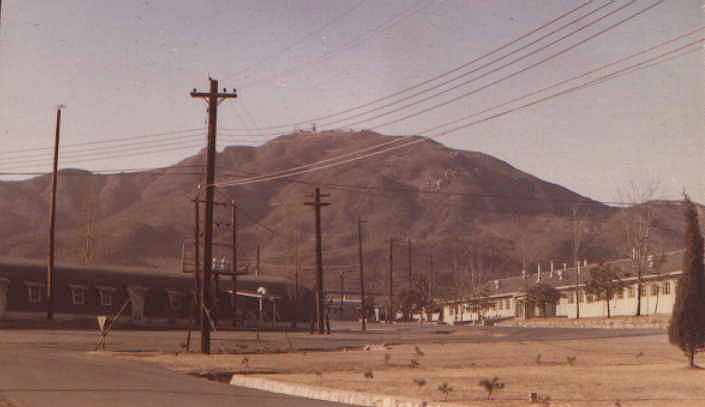
This is a photo of Camp Red Cloud with Hill 468 in the background. This was one of the largest base camps north of Seoul, and was the main headquarters for I Corps division, and all the Commanding Officers were quartered here. Our site (as small as it was) was the Headquarters Battery for the 2nd Hawk Missile Battalion, though we had no missiles here, we were the eyes and the brains (HA!) of the four Line Missile Batteries that were situated on surrounding mountain tops. Since we were in plane view of CRC, our prime directive was to ensure that the radar antenna was always turning, 24 hours a day, 365 days a year, whether the equipment connected to it was working or not. This was for the benefit of not only the North Koreans, who viewed us equally as well from the other side, it also gave the Generals a (false) sense of security, and was really the most important duty we had to perform. The whole role of the Hawk Air defense system in the north end of South Korea was really nothing but a sham. Here's why. The Missile batteries rotate their status so there was only usually one that was "hot" or on "15 minute" status. Since we were not in a combat war, but more of a Cold War, we never had any Line Batteries on a 5 minute alert, so it would take no less than 15 minutes to launch a Hawk missile into the air. All the batteries were situated approximately 5~8 miles from the DMZ. A target was not considered a threat until it passed over the DMZ, at which time an alert was issued. So let's see now, a MIG traveling at say 650+mph (conservative) approaches the DMZ (like so often was the case), but this time it doesn't deflect at the last minute an comes across the line. We pick up the radio phone, and issue the alert to the "hot" battery.... 15 minutes later they're ready to engage the target, and fire a bird.... So where's the MIG now? ...Humm at 650 mph, 15 minutes is approximately 163 miles. So what is wrong with this scenario? The fact of the matter was, a MIG could cross the line, fly down to Seoul, drop a ton of ordinance, and be back in North Korean air space in less than 10 minutes. So actually the role of air defense fell on the Air Force. In fact, in the event of an airborne threat, we were suppose to call the Air Force for initial support. On one occasion we did just that.. A target approached the DMZ, and actually crossed over and was headed south for Seoul. We contacted the "fly boys" and they immediately scrambled a couple of F4s, ... ... .... ... ... ....20 ...minutes ...later, they roared past, looking for a target that had disappeared from our radar 10 minutes earlier!
 This
is how we looked from a neighboring mountain top that was southwest of
us. The DMZ is in the hazy valley to the upper left, and CRC is way down
the valley to the right (out of the photo).
This
is how we looked from a neighboring mountain top that was southwest of
us. The DMZ is in the hazy valley to the upper left, and CRC is way down
the valley to the right (out of the photo).
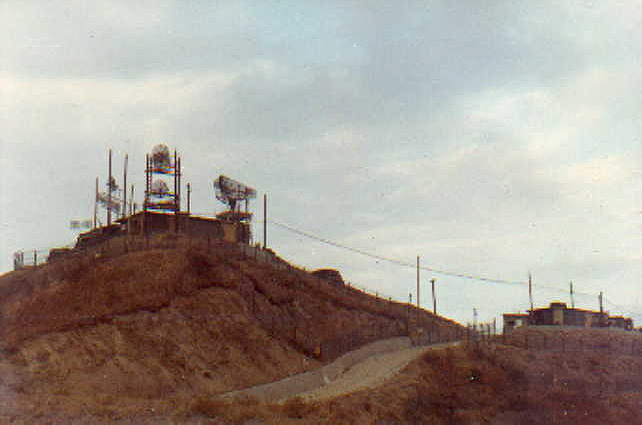 Here's
a close up of the site taken just down the road. The cammo buildings and
all the communications equiptment and antennas belonged to another unit. All we had was
a temporary wooden building, a couple of radar vans, and the big antenna.
Here's
a close up of the site taken just down the road. The cammo buildings and
all the communications equiptment and antennas belonged to another unit. All we had was
a temporary wooden building, a couple of radar vans, and the big antenna.
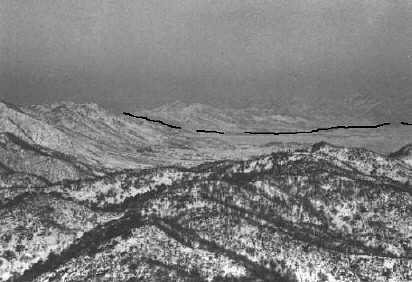 This
photo was taken mid winter, looking north toward the DMZ, which I have
drawn in to show it's approximate location. At night we could see tracers
flying back n' forth from the occasional fire fight. At times there were
even mortar and artillery exchanges. They all made for interesting light
shows, but uneasy times. 7 miles is not very far, when you're watching
ordnance being exchanged. It was very strange to be sitting in the relatively
safe comfort of a heated building, watching the show through the window,
and realizing people were getting shot at down there.
This
photo was taken mid winter, looking north toward the DMZ, which I have
drawn in to show it's approximate location. At night we could see tracers
flying back n' forth from the occasional fire fight. At times there were
even mortar and artillery exchanges. They all made for interesting light
shows, but uneasy times. 7 miles is not very far, when you're watching
ordnance being exchanged. It was very strange to be sitting in the relatively
safe comfort of a heated building, watching the show through the window,
and realizing people were getting shot at down there.
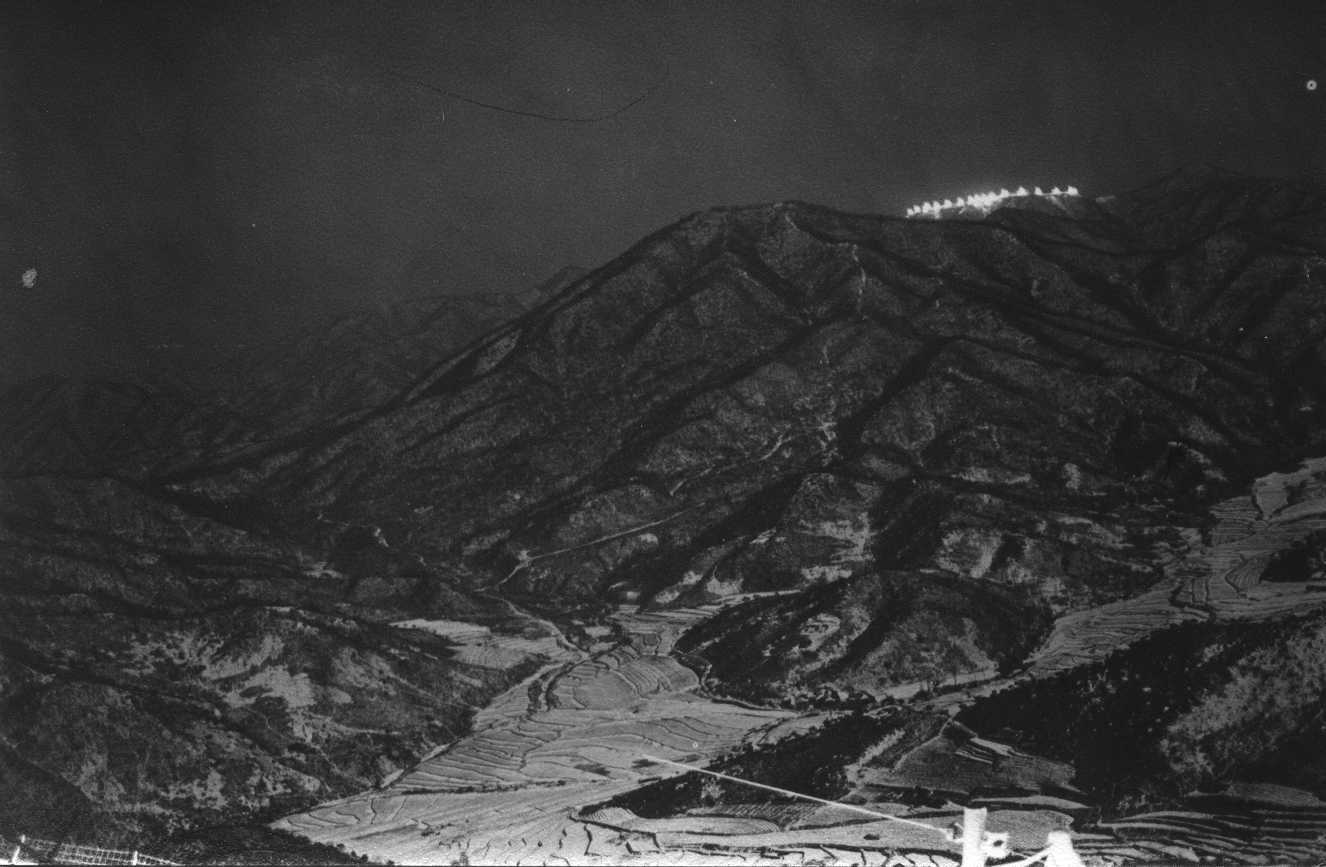 Nightfall was a tense time, since we were lit up like a Christmas tree,
like the Hawk Missile Battery in this photo. This is a shot I took at night
with available light from the full moon. This is looking west from the
top of the hill, and the detail is amazing (you can click on it to see
a much bigger version). You can even see the road that leads
up to the battery. The valley that leads off the picture to the upper left
from center, is how we got over to Seven Rivers Road, We took a side road
that cut off from the road to the Battery, and took us up and over a little
pass into Seven Rivers Valley.
Nightfall was a tense time, since we were lit up like a Christmas tree,
like the Hawk Missile Battery in this photo. This is a shot I took at night
with available light from the full moon. This is looking west from the
top of the hill, and the detail is amazing (you can click on it to see
a much bigger version). You can even see the road that leads
up to the battery. The valley that leads off the picture to the upper left
from center, is how we got over to Seven Rivers Road, We took a side road
that cut off from the road to the Battery, and took us up and over a little
pass into Seven Rivers Valley.
 Here's a day time shot of the same Battery in the night photo above. It
shows the Seven Rivers valley even better. Our adventure took us around
the back side of the mountain in the foreground, and behind the one the
Battery is on (showing the most snow). The ridge in the distance at the
upper left of the photo, forms the far side of Seven Rivers valley, and
that is the ridge we crossed over (no road) to get to the "Unknown Valley"
beyond. As you can see, we were a long way from where we were supposed
to be (CRC is in the valley behind me). It is amazing we (barely) made
it all the way back with 5 gallons of fuel. This is why we didn't want
to try to drive around, it would have been a very long drive.
Here's a day time shot of the same Battery in the night photo above. It
shows the Seven Rivers valley even better. Our adventure took us around
the back side of the mountain in the foreground, and behind the one the
Battery is on (showing the most snow). The ridge in the distance at the
upper left of the photo, forms the far side of Seven Rivers valley, and
that is the ridge we crossed over (no road) to get to the "Unknown Valley"
beyond. As you can see, we were a long way from where we were supposed
to be (CRC is in the valley behind me). It is amazing we (barely) made
it all the way back with 5 gallons of fuel. This is why we didn't want
to try to drive around, it would have been a very long drive.
Each battery had two chain
link parameter fences, topped with barbed wire, with concertina wire in
between, and sandbag bunkers all around the hill top inside the fences,
and the whole parameter was lined with big flood lights (you can see one
of our lights in the photo), that lit the place up like daytime, making
us one big fat juicy target for a MIG or a mortar!
In fact, we took a mortar round
one night that took out a bunker, and blew a hole in both fences! Thankfully
no one was hurt, and even more thankfully, it was my night off the hill! 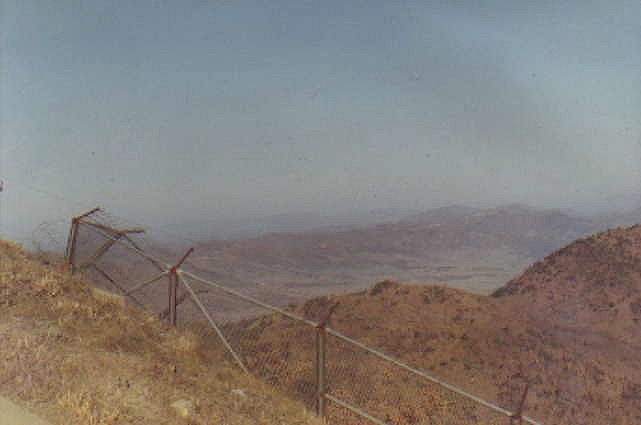 I took this one the next day, showing some of the damage. It is also looking
toward the DMZ down in the valley below. Random attacks like this were
not uncommon, and seldom resulted in any "action" on our part. They were
mostly meant to demoralize, and were usually very short, rarely more than
a one round "hit and run". U.S. troops never pursued these attackers, that
was left to the ROK (Republic Of Korea) Army, and they were tenacious and
ruthless and would hunt down infiltrators until they were found. The North
Koreans knew this, and that is why they always kept the attacks short,
and split as soon as they "popped one off".
I took this one the next day, showing some of the damage. It is also looking
toward the DMZ down in the valley below. Random attacks like this were
not uncommon, and seldom resulted in any "action" on our part. They were
mostly meant to demoralize, and were usually very short, rarely more than
a one round "hit and run". U.S. troops never pursued these attackers, that
was left to the ROK (Republic Of Korea) Army, and they were tenacious and
ruthless and would hunt down infiltrators until they were found. The North
Koreans knew this, and that is why they always kept the attacks short,
and split as soon as they "popped one off".